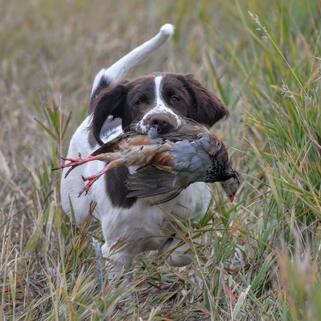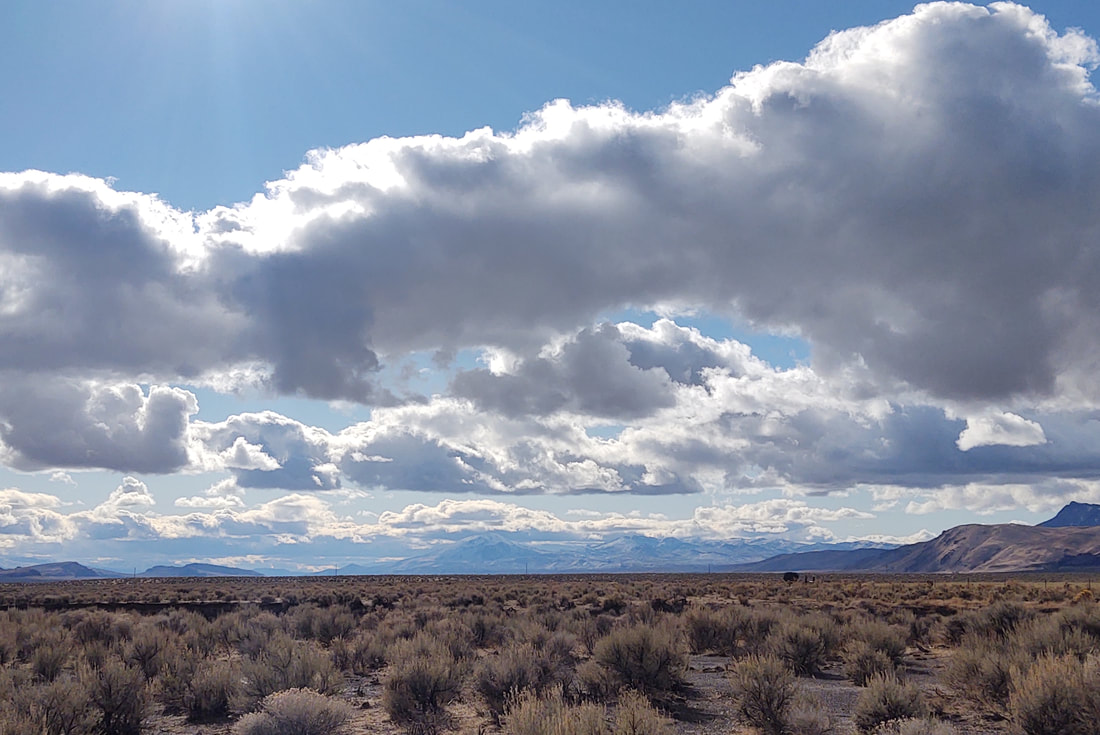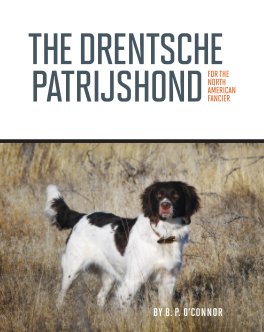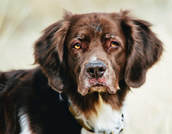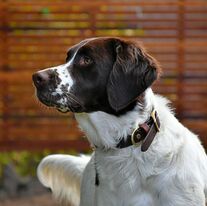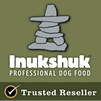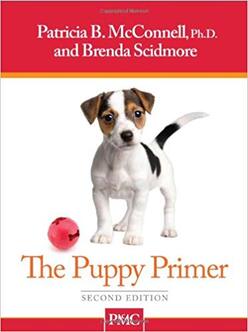 We used to send this by email to our clients many months in advance, now it lives here getting updated from time to time and the link finds its way to your inbox. Yes, we know, it could be a year or more before a new Two Gun pup will cross the threshold into your home. Which means, right now is a wonderful time to start looking into different training options and methods, as there is little pressure. You can read, ask questions, seek out advice, find a local trainer: observe training sessions, etc. and really see what is going to work for you. Making these kinds of decisions once you have the puppy is a whole lot like attempting to fix an airplane while it is in flight...generally not advisable. So here it is, I have dusted off the Recommended Reading list yet once again. What do these books have in common? They are in tune with modern canine behavioral science vs. the old school ways. We believe in working smarter and not harder whenever possible and these resources will certainly help you to do so. Don't Shoot the Dog! The New Art of Teaching and Training, by Karen Pryor The Puppy Primer, by Patricia B. McConnell - for that matter, any Patricia B. McConnell book on training/dog behavior How to raise a puppy you can live with, by Clarice Rutherford When Pigs Fly! Training Success with Impossible Dogs, by Jane Killion, founder/creator of Puppy Culture. This book picks up where we left off with the Puppy Culture protocols, we used with our puppies and isn't just for "impossible" dogs! However, those who are intending to develop your Drent for field work please disregard pages 80-84 her ball & tug games run contrary to your aim. Dog Sense, by John Bradshaw The Genius of Dogs, by Brian Hare Absolutely Positively Gundog Training, by Robert Milner. To learn the mechanics of "Positive/ Force Free Training" and developing a retrieve based on stimulus control. The Drentsche Patrijshond for the North American Fancier, by B. P. O'Connor Since we have you here in the mindset to learn and read. In short, the "early" pediatric spay/neuter is being strongly implicated/tied to joint irregularities, tendon injury, and even increased the risk of many cancers, amongst many other developmental issues, please take some time to review these scientific articles:
There are also some great training resources on the internet:  Leerburg / The Michael Ellis School for Dog trainers: Michael Ellis is considered by many to be one of the World's Greatest dog trainers. He uses LIMA principles to achieve incredible performance from a wide range of dogs for all types of dog sport. Michael's system covers a wide range of topics and is both highly effective, humane, and applicable to all aspects of canine sports. McCann Dog Training: I am a big fan of McCann as they offer a wide range of well put together videos covering all manner of training challenges using Rewards and Markers, and even offer online courses here. Dog Training by Kikopup: Run by Emily Larlham, owner operator of Dogmantics. She shares her impressive skill with easy to learn and follow videos for the regular person. Solving unusual problems suddenly got easier, if not surprisingly fun using her methodology. Higgins GunDogs: Mr. Higgins has used his experience and background in training falcons for the benefit of gun dogs. This method hinges upon a dog's natural cooperation with his boss/co-hunter. The Higgins method isn't exactly 100% fully force and pressure free as its creator pitches. However, the Higgins Method presents stress to the dog in a minimalist and constructive fashion and is without question the best overall and most humane, system for training and managing a high drive gun dog! We use the Higgins Method with all our dogs. Regular visitors to this spot will note I have included Standing Stone Kennels, removed them, reinstated them, and now note they are off again... They have been moving in the right direction. It is important to note that SSK pays their bills by producing content on a rapid production cycle. So, it is important to recognize that the quality of their content varies widely. A knowledgeable trainer can easily sort the wheat from the chaff whereas the novice may not. Therefore, my best advice is to use their content with objective care, or leave it be if you don't know what good training looks like.
0 Comments
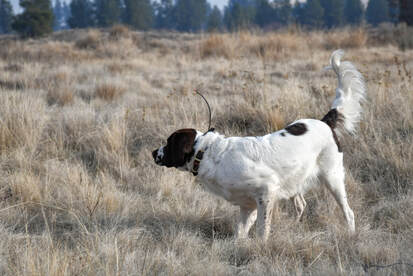
For the three of you who follow my blog, recently renamed The TGK Blog, you will know that I enjoy spending time with my dogs. I’ve come to learn ‘training’ and hunting with them are simply different avenues to cultivate a stronger relationship with them as companions. I’ve ‘trained’ dogs since I was ten years old, and I learned as most of us have at that age by following an adult and using the method they used. It was easy to accept, as there didn’t seem to be any other way to go about ‘training’ a dog. The books that were available at the time only further supported the process. I remember when the Monks of New Skeet’s books were the hottest thing on dog training next to a branding iron ready to go…
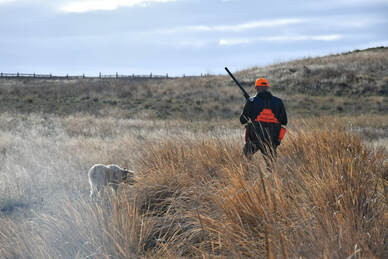
I recall being introduced to ‘clicker’ training in the early 90’s when I lived in Alaska. The way it was presented made me more than just a skeptic, to be honest; I thought it was a joke. I did see there was intent to train without the use of force/pressure/use of harsh aversives. But I just didn’t get it.
It wasn’t until I moved to New Mexico and began training with Janet Miller that I saw ‘balanced training’ in action, and I immediately liked it. I saw the benefits of using things the dog liked to get them to perform versus just making them do it because it is what I wanted. When I got into agility with Shadow, my Golden, through Janet – that was all positive. But I wasn’t clever enough to recognize it at the time. Still, my time training with and learning from Janet redefined how I worked with and wanted to work with my dogs. 
Years later I re-discovered the Drent and really wanted to make this bird dog thing happen. I read dozens of books on training a dog for field use. All of them required the use of force in one way or another. Nothing I was comfortable with, in fact, one book I ordered as a reprint of a famous out of print training book went into explicit detail on how to properly hit your dog with a 2”x4”! Feeling shocked, I recall throwing that book away. Since then, I’ve had the opportunity to train with a few notable gundog guys in New Mexico and Washington. At the puppy end of their programs, it was all fun and games, but to get high trials levels of ‘performance’ aka steadiness, the need for the use of force was there. Still, they weren’t doing some of the incredibly harsh things some so-called trainers were doing. Things that were as shocking if not more so than the 2x4 guy… Fast forward a few years, my own style had become more and more LIMA (Least Invasive Minimally Aversive) through fits and starts in a clumsy haphazard way that tends to occur when a person is without a road map or mentor. I often wondered about how this could apply to the world of Gun Dogs. In the Gun Dog world Positive/Force Free/LIMA ‘training’ is rare as hen’s teeth, and as I have learned, a highly taboo topic.
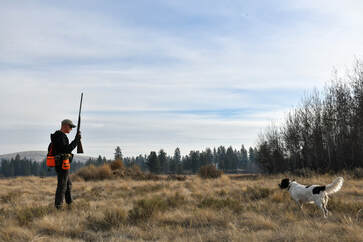
When Jenna had lived in Western Washington state, she trained in a group that used the Gibbons-West method; a low-pressure, low-force way of training for her Fowler dog. This intrigued me – so it was possible! Why had I not heard of this? It made sense to me that training gun dogs should be able to be done without the use of force, after all in nearly all other facets of dog-sport the use of force in training is taboo these days. From Agility, Dog dancing, Flyball, frisbee, even in Mondioring and so many points in between people have been getting high drive dogs to do totally amazing things. More importantly, how have they done it? Well, the more amazing the behavior has been, the more likely it is that the handler/trainer has gotten the dog to offer the behavior and then rewarded the dog for doing so. Then the act of performing became rewarding for the dog. The dog chooses compliance… 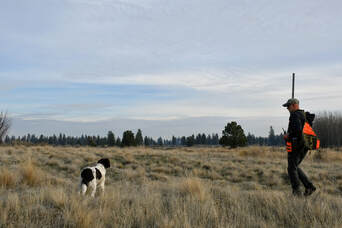
Jenna suggested we try to train with Brad Higgins. Contact was made, and the appointment set. I don’t recall the last time I was so excited to learn something. From the moment you arrive, you are being educated. This I loved. I will not bore you with repeating the experience here, as I have written about it already. In short, I will say this, we both had a wonderful experience and came away with our eyes opened further and our heads reeling from trying to take in so much added information. We returned home with elevated expectations for the hunting season and how we would ‘train’ the following summer. Sadly, our original quail lady had elected to skip out on far more than producing quail for us, so our big summer of working with Ila and Tule was tabled. I did, however, add several books to my pile to read.
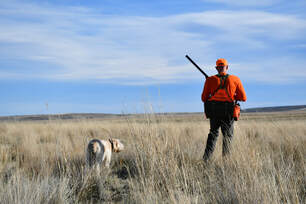
Just like leading up to our first Higgins experience dumping out old irrelevant information was without question the single greatest hurdle to learning the new. Learning is a journey, a fantastic one if you are ready and wanting to grow. I had become inspired and given the impetus to make another big step in the direction I had been pointed for a long time. This time with purpose and direction and possibly a mentor. With this experience fresh in my mind, I reread several canine behavior books – now with a whole new level of meaning and a much deeper level of understanding. I also joined force free training groups, added all kinds of books on learning theory, modern force free training methodology to my reading pile.

Over that summer I realized I, more than Ila, needed to go back to train with Brad. I returned to Nevada and with Brad’s help we focused intently on my handling. Brad videoed me and he critiqued my handling, missed queues, off timing, and the few things I did well. It was then he went from teacher to mentor. I had a lot of respect for Brad before, his care and passion are unmistakable, and dare I say it, palpable. We covered a lot of ground, I learned a great deal about myself and what I was doing, or rather what I thought I was doing. I spent those days so focused and deep in concentration I ended up with a truly crushing migraine – I had thrown everything I had at learning.
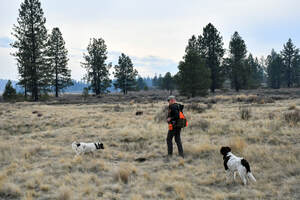
It should go without saying, Jenna and I had a great hunting season, better yet we had secured a new quail lady! Amanda has been fantastic. She works hard to deliver healthy strong birds for our program, and we are appreciative of her great attitude and commitment towards helping us achieve our goals. For this first summer of having a flight pen full of quail, we used Pharaoh quail. Amanda brought in a strain that was going to be edgier than the normal docile pharoah for us. While some were flightier, most were not so impressive. We learned the lighter color the bird was, the more likely it was to act wild. Ultra-rare it was when a rich-brown or dark grey one got up and left Dodge.
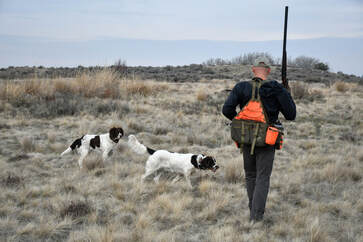
With the Higgins method it has been my observation that the use of pressure and harsh aversives are replaced with structure. To be successful with the Higgins method you need birds that will act wild, and you need to adhere to a deviously simple protocol. With some patience and a few good birds, the dog comes to understand you are critical to its success as a hunter. Better yet, the dog believes you are the key to his success! With this ‘truth’ installed in the dog’s mind his level of cooperation is amplified. All you have to do is not screw it up. This relationship is built upon trust and cooperation. The more this is allowed to grow, the higher the level of performance you will get from your dog: better bird management, points that are stauncher and more dramatic, and yes, even better retrieves. All by basically just slowing down, being quiet, paying attention and being calm - of course a gross oversimplification.
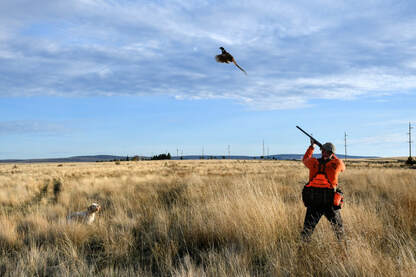
this may So back to our pharaohs. One of the more interesting and useful parts of the Higgins Method is allowing the dog to flush. Yes, it seems unusual and maybe even quite contrary. But after your dog has established its point, and you have situated yourself the dog is taught the “all right” queue, where the dog has permission to charge in and flush the bird, or simply relocate, or stand and defer to you. But in many cases one or two explosive steps is all it takes to get a bird to break and its game on. Do you like to shoot doubles? Here is your chance. What we learned in ‘training’ is our birds wouldn’t go and the girls would simply scoop the bird up on the “all right” – which technically is fair play, but what wild bird would let that happen? Moreover, this ninja grabbing became problematic for us, most notably Ila learned to stalk in like a panther and snatch the bird. There is a clear difference between when a dog is managing birds and creeping. Ila still didn’t have intent to put the bird up because if it flew, she stood steady, but if it sat tight, she would panther cruise in until the bird was in her mouth.
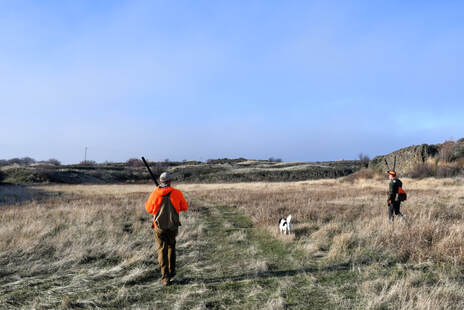
We consulted with Brad, and he confirmed our suspicions – we had a bird problem. To move forward we had to ditch “all right” at least temporarily. But what to do about Ila, the furry bird snatching glacier? Since we don’t use “whoa” or zap our dogs, just what were our options? Well truth be told; the solution was incredibly simple. I knew the difference between Ila managing a bird on the move, and when she had intent to cruise in for a snatch. This was the cornerstone to the fix. When she went into cruise mode, I simply recalled her, I knelt and praised her for returning and we left that bird alone and went to another. She was denied her reward, which is all. It took two times that day, and another on the following training day. She hasn’t cruised since. No yelling, no whistle bleating, no “whoa'ing", no zapping, no dramas; it was that simple.
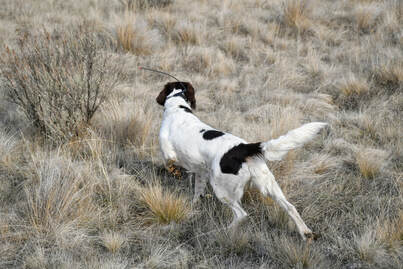
In all we had a great summer of fun Ila, Tule, and I. We ‘trained’ three or four days a week. I honed my craft and improved my timing by taking video of most of our sessions. I did learn I am a terrible videographer, but what I managed to capture was adequate for its intended purpose, for me to learn and improve. Yes, with the Higgins Method the handler is held accountable for what goes on and how well the dog performs. We understand what the dog will do when they make associations. With consistency in handling, it becomes easy for the dog to make the associations we find desirable. In this case awesome points and steadiness, basically the dog becomes non-reactive to birds flying, gunfire, birds being shot, etc. Chasing is eliminated entirely. All the things I just mentioned become queues to remain steady for the dog, all done without drama, pressure, hollering a 'command', or zapping the dog. Early in the program dogs are helped to make the association that flying/flushing birds mean to be steady without verbal commands or queues be it verbal or electronic. We then make the association that they may flush the bird, but become steady again once the bird flies, again without command or queue from us, the flying bird is again our queue for steadiness. This is much easier than you might think.
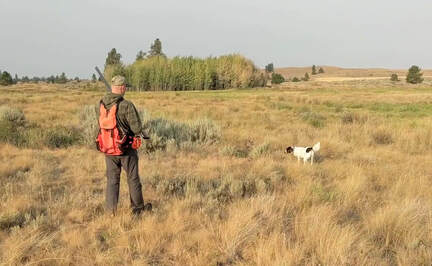
Once the gun gets involved a lot of energy is added to the situation, and once we have added a bird tumbling to the ground, there is again even more energy added. For us, this isn’t an insurmountable obstacle for us, and one we can defeat without the use of any kind of harshness. Our dogs learn the gunfire is also a queue for steadiness. Even while hunting at our local preserve hunters in other fields shooting will cause our dogs to pause briefly. Typically, the opposite of dogs trained conventionally, who when they hear gunfire usually rocket off in the direction of the report of the shot! Because so many of our birds were very weak to get off the line, I had to put a bit more emphasis on gunfire, being a queue for steadiness to ensure the safety of the situation. Again, this was done without the use of force. I simply leaned a little further into the associations we had already built.
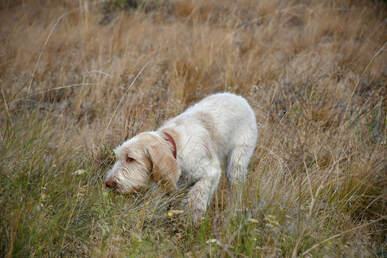
How did I do that? To be honest it was simple and based on modern learning theory. Done again in the Higgins way, as quietly as I am capable of. By emphasizing my return to the dog after the shot, varying the time to get back, and varying the time for release once I got back to the dog, my queue “hunt dead” was properly reinforced as the association I wanted to make. Releasing the dog is easy, there is a lot going on, a lot of energy and excitement in the air, and usually a downed bird to be found and retrieved. Once we had the release ironed out, on occasion I would let the girls go without returning to them, but only if they remained steady and turned to look for me – anticipate my return to them. This will be the area I focus on through the upcoming hunting season. I intend to be mindful of making a point to return to them on occasion before offering the “hunt dead” queue. Just a few times here and there will be all it takes to keep the whole thing together.

I ended my ‘training’ season by starting our Spinone pup using the Higgins Method with remarkable success and having two Drents that were dead nuts bang on steady to release.
With the few birds I had left I elected to try working Tule & Ila as a brace. They both played the game by the same set of ‘rules’, and they both used the same queues to the same level of fidelity no less. I wasn’t nervous about running them together at all. I just wanted to see how it would go down. Tule works closer, Ila tends to run bigger. As a pair it’s about perfect. They worked so well together, very cooperative! If Ila has the bird, Tule very naturally will honor her. Once I walked past her, she would resume working and either establish her own point or would again ‘honor’ depending on the wind or situation. Ila is by default of her personality is a risk taker, instead of ‘honoring’ she would work around and set her own point in her own way at the distance she thought was right for the situation – never with the intent to compete or interfere. Yeah, so just like that I now have a brace of Higgins dogs. Lucky me. 
Haha, I say it like it just happened, but in some ways it did because we all just had a lot of fun over the course of last summer. We learned a lot from one another. Trust, timing, teamwork. I improved my handling, timing, and consistency. My patience and persistence grew by using the video because I stopped repeating mistakes, and even when I did repeat an error it was never to the degree it was before – improvement is the name of the game. So really it was through diligence and attention to detail I have a brace of Higgins Gundogs and an eight-month-old pup that performs better than most folks seasoned pros…
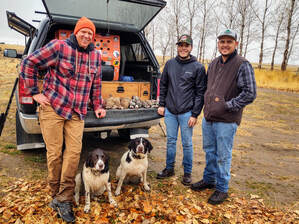
We even got to take our act on the road and offered guiding services for Sage Canyon Outfitters in Oregon where every client we took out made similar remarks about enjoying the slower more casual pace of the hunt, the quiet: no yelling or whistle bleating from me, and never hearing a dog squeal from being shocked – they all commented on that and how much it bothered them to see it happen to the other guys dogs. Additionally, they really liked being able to get set up around the dogs they watched work and with a ‘thumbs up’ all around the “all right” was given and easy shots presented to the guns.
Everywhere I go, and the tailgate gets opened, or every time I post a photo that shows my truck vault people take notice of my drawer system. A little backstory for you, my friend Dave had offered to build me a vault for several years, and I finally built the courage to ask him to help me make it happen. We set a weekend and I drove over to Bozeman. Dave got a head start by picking up the bulk of the supplies needed and went started by laminating and cross-screwing two sheets of 3/4" together to make the uprights of the box. I arrived, and the flurry of activity started! From start to finish I have ~$500 worth of materials involved: wood, screws, glue, finishes, hardware and so on. Currently I have the top surface/load deck coated in Flexi Seal after using various other deck/fence paints with varying levels of success. The top surface of the load deck from the bed is 10.25". The box and drawers are all made from 3/4" hardwood plywood. The uprights are doubled up, cross screwed and laminated. I've had 3,100 pounds loaded on top and the drawers still worked perfectly. Down the center of my box, I have 6" lag bolts punched through the centers of my medium duty tie-down anchors, strategically placed based on various kennel arrangements and use oak runners with 2,500# ratchet straps to secure my kennels. We can carry: 4 Roughland Intermediates, or 3 Roughland Intermediates and a Roughland Large, or 3 Roughland Intermediates and 2 Roughland Mediums. The drawers are about 10" deep and are about 6'1" long and ride on hand planed waxed oak sliders. The two small side drawers run to the wheel well. One holds grooming tools, and water port parts, the other ammo. The Ammo drawer was built to hold 12 ga ammo. The area ahead of the wheel well, I could use as drop in storage, I just haven't cut the panels for it. I've added some notes to the slide show to make it easier to pair comments with photos. Enjoy, and if you have questions or comments, please feel free to reach out. The complete and unabridged version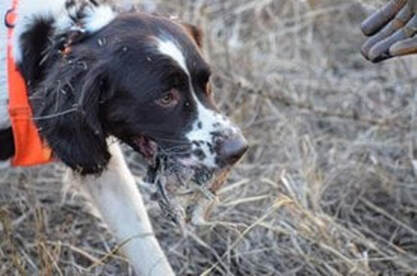 So, what’s it like to hunt over a Drentsche Patrijshond, one of North America’s rarest versatile pointing breeds? And what if the game you were hunting was one of North America’s most prized birds, an uncommon species many hunters have pinned to the top of their bird hunting bucket list? I’m going to go out on a limb and guess most of you do not know what a Drentsche Patrijshond, aka Drent, is and without boring you with a textbook introduction to the breed, I’ll offer this snapshot. The Drent is nearly four hundred years old, and, unlike the German versatile breeds, it was developed in a more organic way. For example, in the Dutch Province of Drenthe, located in the northeastern part of the Netherlands, commoners had the right to hunt. But most of them were quite poor and couldn’t afford more than one dog. Therefore, that one dog had to do it all; keep vermin out of the barn, pull a cart full of produce or cheese to market, play with the children, warn of approaching strangers, and yes of course, hunt. The rest I hope to convey with an account from the field. I am by all accounts a Mearns quail hunting nutter and have spent no less than one hundred and thirty days over the past eleven years hunting them along our southern border, I’ve identified two different color phases of the female and four different crest patterns of the male. Forecast reports, bird counts and weather, mean little to me, as I am drawn to the region for its ruggedness and austere beauty, locally produced wine, and of course the opportunity to meet up with friends to hunt these amazing little birds. This hunt took place a couple of years ago. Accompanying me was my favorite and cutest hunting partner ever, my wife Jenna. We had planned to hunt with a duo of dogs. First, Jenna’s boy Fowler, a classic Nimrod-type Drent, who is at the heavily coated end of the spectrum for the breed. He was eight years old at the time and sports a fluffy white tail you simply can’t miss. Additionally, he happens to be the first NAVHDA UT titled Drent. He would hunt with my girl, a Drent with heavy Clovis-type influences, a coat at the opposite end of what is considered allowable and nearly all white. She moves like a flash of lightning, scales rocky slopes like Spiderman, is my medical response Service Dog, and is one of the most honest dogs I’ve hunted over. The difference in type boils down to subtle variations in skull structure and overall bone mass of the dog. A Clovis dog will have a bit more of a heavier and domed skull and carry more bone than a Nimrod type, with a flatter and more wedged-shaped skull. Both are wonderful examples of each type and really show the allowable variation within the breed between them. Of note, there is quite a bit of allowable variation in the breed and one really needs to spend time learning breed to know what ‘right looks like’ – but once you know, it’s easy to spot those who fall outside the boundaries of fair play.  On this hunt, the action had been slow but steady. Down from the year before – an all to familiar trend. Yet, when we asked other hunters about their hunts, it seemed like we were finding more birds than most of them – again, nothing new to us, but that isn’t to say we don’t work for it. After all, some days are hard. This day’s location was brand new and was chosen primarily by looking over satellite imagery and making comparisons to other areas where we’d had success before. As we wound our way to a suitable parking spot, attempting to avoid as much of the catclaw and mesquite branches as possible, I can tell you this; it did not look anything like the traditional old man strolls you see in video footage or photos you see in print. This place looked daunting. This was going to be something: a proper canyon, much bigger than we had realized. Still, we were committed, being so far off the beaten path, with the sun already coming up. How hard could it be? After all, it had already been a tough season, so why not hunt this ragged gash tucked deep into the Madrean Sky Island habitat of the Chihuahuan Desert? The end of the trail for the Power wagon was break under a large evergreen oak. The peaks towering ahead of us were a bit over a thousand feet above the boulder strewn creek bottom we parked on. This was going to be interesting; we had all the right habitat even if it was much rockier and vertical than what most people are looking to hunt, or so we thought. We booted the dogs up and readied ourselves for a long hike. As Jenna was gathering snacks for the hike, and I was relieving myself of my coffee rental, I heard “the dogs are on point!”. Standing there, with the wrong gun in my hand, I said “what!?”. “Powder and Fowler are both on point” she said. Less than fifteen yards from the front of the truck, on the steep bank of the mouth of the canyon, the dogs were sharing a point on a covey of Mearns. Both neatly crouched, as is most typical, frozen in time and space on the steep embankment. A Drent’s tail is a good barometer as to what may be in front of him or her. A flagging tail generally indicates the dog is unsure; maybe the birds are running out? But when they are sure, you will see that brushy tail outstretched, positioned between two and three o’clock, in-line with the backbone much like the tail of a weathervane – it’s just how they are built, there is no changing it. A Drent’s tail is there mostly to knock things off the end table. I carefully made my way forward with a handful of shells hastily jammed into my front pocket. And that is when I realized just how steep the embankment was. The covey flushed as I neared Fowler as a dry branch snapped underfoot. Most of the birds flew straight up and into the sun, but one juvenile bull made a tactical mistake and veered left. My shot connected just before he crested the rise of this spit of land which would have allowed him to really travel. With minimal interference from me, Powder was on the retrieve. Drents have a strong retrieving instinct and can rival more traditional retrieving breeds. In fact, doubly so if the right training methodologies are employed. The breed has a reputation for being both soft and stubborn, but I challenge the notion of stubbornness after having trained a dozen or so Drents. Using traditional training methods, Drents will become either bored, frustrated, or worse yet, intimidated and will shut down, leading many to think they are stubborn. Since I have converted to ‘Force-Free training’ for all aspects of my training program; from the mundane, to field and retrieving work. I’ve not experienced a ‘shut-down’ (stubborn) dog since. Moreover, this change has enabled me to tap into the Drent’s innate desire to please and work with their ‘boss’. We were on the board right from the start. How about that? 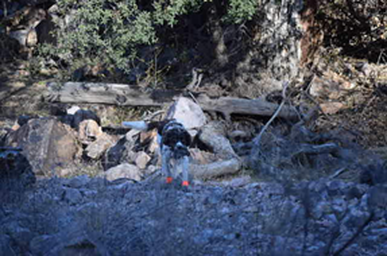 With this rather immediate and unexpected success, we set out into the canyon. In Sky Island country, conditions and temperatures can change throughout the day depending on the orientation of the land in relation to the sun, and of course changes in elevation. We rounded a bend, barely ten minutes from leaving the truck. My GPS told me Powder was on point up ahead and above us in the full heat of the sun. She had worked just out of eyesight. A Drent will adjust its range depending on conditions and terrain to remain in loose contact with the gun, with ranges typically flexing between thirty yards for deep brush and out to around one hundred and fifty yards or more in the open. The Drent was, after all, built by foot hunters for foot hunters to hunt patchwork fields customarily separated by dense hedgerows and the brushy edges of watery dikes surrounding polders. But that wasn’t the case here. I began my ascent up the steep side, carefully negotiating the crumbly slope dotted with scabby grasses. Every step up was reduced by half as the soft unset rock gave way. I had to use the edge of my Kenetrek boots in an effort to gain purchase. Progress was slow, and the heat of the unfiltered sun was withering. Yet, Powder held her point. The covey was moving, but they were in no rush. She would take an occasional step and re-establish her point. Drents are highly intelligent and learn early how to gauge scent as well as the movement of their quarry. Mearns are renowned for holding tight for the pointing dog, which is only somewhat true these days. It seems, too many hunters have taken advantage of the Mearns’ predictability. This coupled with increased hunting pressure of recent years, has all the dedicated talking about the change in Mearns tactics. Some will hold, while many will run like their more common desert brethren. Most recently I’ve witnessed coveys flush wild from a hundred yards away or more – if I wanted to hunt Huns, I’d go to Montana! These are not the Fool’s Quail of yore, which have enticed many to hunt them. As my body heat began to fog my safety glasses, I opened my vest for ventilation. Powder held her point but when I paused to catch my breath or sort my gear out, she looked back to verify my location and progress. This is quite typical for the Drent. As a breed they are naturally cooperative team hunters which thrive under benevolent leadership. I believe the Drent to be ideal for the hunter who wants to hunt with a friend and is willing to trust their dog to make decisions versus a four-legged tool – there are other breeds for that. 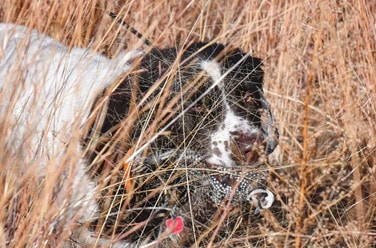 As I neared her, my steps became more tentative on the steep unstable surface. I worked to get above her, managed to get parallel to her and paused. The footing was better, and she hadn’t moved in some time. The birds were close. Powder shifted her gaze to me, then looked forward and stretched her neck. I released her to flush the birds. I set my bead on the dark underside of a large bull quail flying uphill towards the deep grass. With a puff of feathers and cartwheeling wings, he pitched in. I asked Powder to make the retrieve. It was an easy find, as he was caught in a dramatic flutter as gravity wedged him into the base of a dense tuft of grass. Two birds down already. It was shaping up to be a genuinely nice day. Might I have enough tender Mearns meat to make a batch of my somewhat famous quail Posole by the end of the day? For sure I’d be able to put them to use in my quail Marsala recipe. Maybe I was getting ahead of myself... Moving down hill is quicker than going up, so within a moment we were back to Jenna and Fowler and boy was he ready to go! A few yards further we entered the throat of the main canyon where the conditions swung a full 180-degrees. It was as if the canyon was alive and breathing. As the ‘outside’ temperature was rising, it was causing an inversion in the canyon, forcing freezing cold air from the upper reaches of the system down and out the mouth. Then after a few minutes this ‘push’ would stabilize, and just as you could get feeling worked back into your fingers, another push of arctic grade air would snake through, stinging our eyes, cheeks, thinly gloved hands, and sending chills into our cores. Was it the second push of this artic air, or the third? One of them caused Fowler to move forward in an entranced walk, as if here were stalking something. He moved in this way for over a hundred yards. He took a long pause in the creek bottom; the thermal belt had paused again. Powder caught up but was staying clear of Fowler. She knew he had something she hadn’t caught a hold of. Then the cold air drainage restarted, our glasses fogged, and Fowler began to move again, this time couched, like panther stalking its prey. Powder moved alongside, also stalking. But it was clear she still did not have the scent; she was just mimicking Fowler’s movements as she carefully picked her way through the dense catclaw. 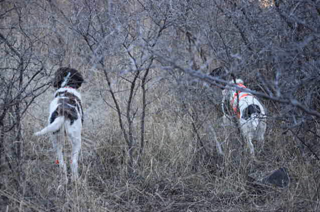 Fowler scaled the short cut bank to a grassy plateau choked with catclaw and dense grass. A few mature evergreen oaks dotted the braided boulder laden creek bottom. Both dogs froze like statuary, a bit more upright than normal. But here was no way for Jenna and I to get through the catclaw, we had to stay in the creek bed and work our way around until we could find a break and work our way in. As we did, the Drents took turns, one pointing the other backing, and then switching roles. This team stalking is something we are very used to, and just love being a part of it. As we rounded the bend to get onto the island with the dogs, Powder slipped down into a braid of the creek on the far side. She had managed to work up wind of the covey and come back in from above. Team Double Dutch had the covey in a pincer with only one way out, across the other portion of the creek bed, and up a rocky landslide which had tumbled from the canyon top a thousand feet above. I didn’t need to release the dogs to flush. As I found stable footing, I found myself in the middle of the covey. Birds erupted from all around me, I fired, then fired again – a double. Birds continued to flush! There were at least two dozen of them. What a find! This was easily two if not three family groups together, a regional conference. If I’d had better presence of mind I could have reloaded and taken more as several quail were late to depart in a delayed popcorn flush. Were we the first hunters to make contact with these birds this year? With three rich covey finds in this first hour of hunting and four birds in the game bag this was setting up to be a wonderful day afield. As we made our way further into the canyon the cold air pulses continued at regular intervals, the gentle whooshes lasted just long enough to make us wonder if we were crazy. Then they would subside long enough to rewarm ourselves as we trekked further in and up the rocky creek bottom. Each bend was different. Shaded, cool and comfortable, or fully sunlit and broiling hot. Around yet another bend the scene would be wrapped in shadow, a place where the hoar frost grew to epic proportions in its freezing shadowy depths.  It was in one of these shadowlands that we noticed both dogs on point; Fowler high up in the sun near a partially burned oak and Powder low in a bramble of brush, grass, and younger oaks. As I approached Powder her point intensified, I had to pause to take stock of the situation. She checked in with me, then I resumed by circling to her right and coming over a slight ridge covered with some tall dense grass. A single sunbeam had managed to penetrate the cold and darkness around us. Meanwhile just a few feet away, Powder lowered her head, her breath melting the frost on the grass in front of her. It was a tight spot to be in. I gave her the release command, but all she did was look me in the eye, then look ahead and nod her head as if to say – they are right here! Sure enough, there was a covey right in front of me, tucked away in a patch of gently warming frost-free grass. I carefully looped the shotgun over my shoulder and lifted the camera up to rattle off a few shots hoping desperately the autofocus would find a way to grab a quail or two through the grass. I put the camera away, grabbed my gun and took a step. All hell broke loose! Quail shot out of that grass like popcorn on a stove top; bouncing off branches, zinging here and there, and just when I thought the show was over, one hen lit through my little window. It proved to be an unfortunate decision for her, but still there was enough vegetation to keep it from being a super clean shot, and she buzzed off a short distance. Easy for Powder to relocate, but where was Fowler? Funny thing about Mearns, their habitat is immense. You can find them on flat easy walks in the open chaparral, or tucked away under clumps of cat claw, most of all, you find them where they are – in the most unlikely and damnedest places. He was still up on the hillside, still pointing – good boy! Powder located our little hen with a bonus point and flush at her release. Five birds and six shots today – I’m on fire and still have a dog on point. By the time I was able to get to Fowler, his tail had begun to flag, which was a sign of things to come. 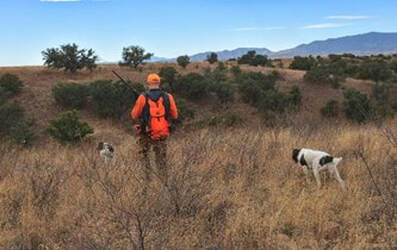 Still Powder backed him once she got to within a few yards… and that’s when the large Coatimundi (Nasua nasua, a member of the raccoon family found in Arizona) decided to make a break for it and climb to the top of the tree. We had a good laugh and were glad that the big male Coati didn’t want any trouble. Pushing ever higher the canyon opened and began to resemble more typical Mearns country. This one, however, was on a breath-taking scale. We had gained enough elevation to make our way into the chaparral where the winds could blow. And with the wind blowing, we knew we’d probably have some running birds, even in a place like this. It wasn’t long before our beloved Drents made bird contact again on a lower bench which led up to the highest reaches. Powder and Fowler were exchanging roles, pointing and backing, with Fowler mostly in the lead. Up and up we went, and the higher we got, the stronger the wind. The birds were running. We’d catch a glimpse of one here and another there cutting and running from grass clump to catclaw in the scabby open area and gusting winds. They were like phantoms. I’m sure I had seen them darting about. Fowler managed to get a nice long point, but we just couldn’t get up hill fast enough to his side. Powder was running from side to side behind us, as if marshalling nervous birds, stopping to pause when Fowler pointed. 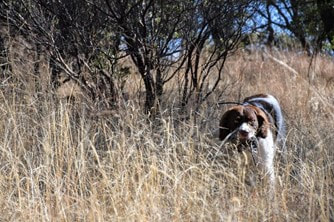 Then, just as we thought we were in the money and ready for a shot, the most peculiar thing happened. The quail began to talk. I’ve never heard them chatter like this before, a harmony of high-pitched alerts, sounding much line a bubbling spring to notify their mates of a strategy change. For us, it was a wave of excitement washed with confusion; after all, how could they be so close, yet never appear? But when the chatter stopped, the grasses jostled violently as the quail began running again. The covey had split up and were hauling ass every which way, except towards us. We continued to press them to the top. This was a grudge match now. Once at the top, on the backside of a depression, and out of the wind, Fowler nailed a solid point. Powder backed. I was able to walk in like royalty, right past Powder, then past Fowler. The few remaining birds flushed. I took one on a nice passing shot as it headed into the air current. The other barrel I let off just because I enjoy the sound and wanted to strike fear into their little hearts (no seriously, I missed like everyone does). We had a great day, our dogs had a great day, and we had a long walk back to the truck. Despite the Drent being established nearly half a millennia ago half the world away by farmers for farmers to hunt hedgerows and patchwork fields, it seems to me, the Drent’s qualities are perfectly suited for hunting these native polka dotted kings of the high desert. Our success, is perhaps a case of having the right tool for the job? I’d like to think so. Scenting conditions can be difficult in the heat of the sun and scabby dry grass, having a dog that will calmly work areas and stay on task, make effective calculations on its own, and work as a team seems to be a winning combination. Since this was an out and back hunt, I found one of Fowler’s favorite songs in my music library, Prince’s Purple Rain, and put it on speaker as we headed back down our boulder strewn path. We’ll see you all again next year. 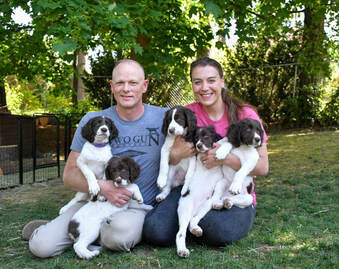 Well hello to you my loyal reader. Sorry it has been a terribly slow year for the blog, just because it has been slow here it doesn’t mean we have been just laying around drinking beer and eating potato chips! If only life could be so grand! Obviously, we had an exciting and gorgeous litter of puppies from Tule and Fen. After they all went to their homes, we took action on something we have been making casual threats at for the past couple of years and added a non-Drent to the household! You may have seen Fizzy on our social media. In short, we each had our list and had come to be okay with at least one breed from each other’s list but after hosting Laura Reeves for our puppy evals, we were presented with an opportunity we just couldn’t pass on – a Spinone Italiano pup. Not just any Spinone, but one from a breeder who has a proven knack for producing a disproportionate number of the top winning Spinone in the nation! So just like that, Fizzy came into our lives.
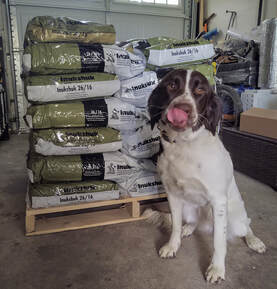 In addition to looking high and low for remarkable studs to “import” for our program, managing a litter, volunteer Instructing for Ladies Hunting Camp, we become a distributor for Inukshuk Professional Dog Food, and getting this super cool Spinone as already mentioned. Additionally, we built a flight pen for keeping quail. If you have been following us, you know we use the Higgins Method for force-free field ‘training’ for all of our dogs (to include the Spinone). One of the biggest challenges with using the Higgins Method is the need for birds that will fly. You can get the basics done in a shockingly short amount of time, however, to polish your handling skills and get to a high level of performance, your need for good flying birds is significant. On the bright side, each session is a replication of a hunting scenario where you and your dog learn and gain experience as a team. With proper attention to detail your team performance will creep ever closer to perfection.
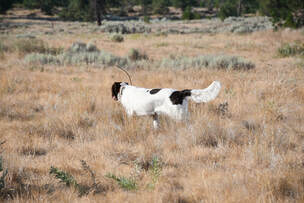 Well, the quail situation took a massive hit one evening shortly after my son’s summer visit began. Two nights after a large intake of quail, we had a Trash Panda probing our flight pen, and despite shoring up defenses it/they finally made their move and massacred 40 quail. It was a tragic sight to behold. Terrible if not terrifying was the aftermath. A buddy of mine lent me a live trap to use. So the trap was set and our Ghost in the Darkness managed to take all the bait, without getting trapped and still dig into the pen, and left a dump right in the middle. It is clear we are dealing with an experienced urban troublemaker. We went back to the drawing board with our security plan, dug trenches, sank heavy gauge fencing, weighted with bricks and rocks, and added a solar powered electric fence rated to contain large unruly livestock. We have had two confirmed attempts to breach since, but the juice has been too much. Giddyap, zap, zap, motherf’er! 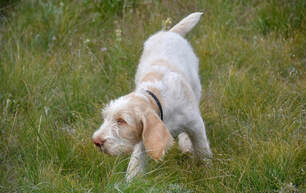 So, in short, we have been running to and from puppy classes, doing bird work with our dogs, and *gasp* living a bit of life. Yeah, I know that too takes time and energy too. With that, blog posts have been negligible, and my consumption of books has been reduced to a trickle. On the upside, Jenna and I have come a long way with our team handling, and it shows in the improved performance of our dogs. Ila is nearly finished, Tule is holding her own, and baby Fizzy is legitimately doing great work for us – but in all honestly her lower energy level has made the process very easy. 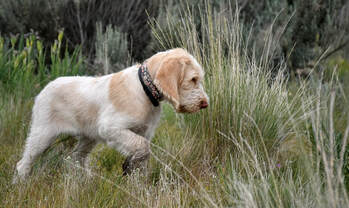 It’s mid-August now, just a few days away from Powder’s x-ray which is a stressful time for us. Her pregnancy was confirmed by ultrasound, which was of some comfort. But to be honest all it really did was mark the start of The Great Wait. How many are in there? Will any be reabsorbed? Will they all arrive safe and full of life? Those are all great questions. Powder’s x-ray is close on the horizon, and that will be a big help. A quality x-ray can show us many things and help us to set expectations for delivery day. Until then we wait. Trying not to get overly excited and get our expectations too high, while at the same time trying not to judge how she looked during previous pregnancies to arrive at some guestimate as to what may or may not be happening. The random whelping supplies we needed to replenish our stocks have all arrived, the whelping room has been cleaned, set up, and arranged. So, with that I need to get ready for the concert tonight. Until next time, take care and thanks for stopping by.
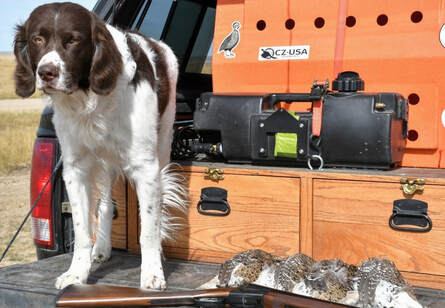 I’ve been holding on to this for quite a long time… life has been keeping me busy of late and so I haven’t done much with it other than to think I should do something about it from time to time. Well, it appears its time has come do something about it! So, let’s talk briefly about the travel crate and what ‘right’ looks like. I’m very happy I came across this infographic as it shows us what is more likely to be safer and prevent injury to your dog in the event you are in an accident or have to take some abrupt actions to avoid an accident. We have seat belts and airbags, your dog? Well, is it loose in your car? In the bed of your truck? Or is it in a kennel and if so, is it secured and sized correctly? While your dog’s crate at home should be fairly roomy his travel crate should not be. In fact a travel crate your dog should be touching 3 of 4 walls at any time when laying down, and it should be snug enough that it encourages your dog to lay down and discourage moving around! This snugness keeps your dog from being tossed around inside the kennel in the event of sudden changes e.g., hard braking, accident-avoidance maneuvers, or possibly an accident. But for this to really work, your dog’s kennel will need to be secured fast in your vehicle. Consider tiedown straps hooked into your vehicle’s child seat restraint moorings, a seatbelt alone is likely to allow slippage. The same goes for bed of your truck, if not more so. You will want to keep his kennel as stable and securely mounted as possible to allow the kennel to help protect your dog. With all of this having been said, it is important to recognize that being in such a snug environment you now have a responsibility to ‘air your dog out’. Dogs do spend a great deal of their day sleeping, and this is what most will do when traveling, however they cannot stretch out from time to time, and can cause some stiffness in some dogs. The rule of thumb we use is, for every 3 to 4 hours of driving your dog should get about 30 minutes of time to stretch, walk, and potty. 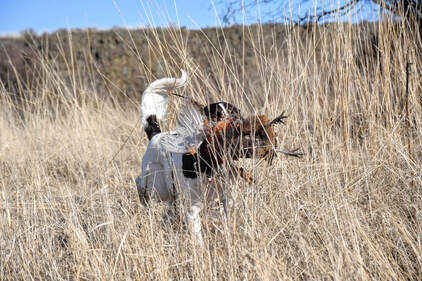 So three years after this was originally published, it's time for a little update. So if you are one of the few people who check in here from time to time, thank you and I hope you enjoy. In the world of dog food there is an abundance of mythology and folk lore surrounding what constitutes a good dog food and kibble manufacturers have a kibble for every budget out there! Many companies cater to our instinct to provide the best we can afford to our four-legged family members using powerful modern marketing strategies which take advantage of our instincts and desires by leveraging our biases, and ignorance. Yes, it's like that. Most likely, just as you have done, we have poured over tons of dog food comparison websites in search of the kibble with the most stars or dog bones a particular website will dare honor a kibble with. About eleven years ago now I found The Dog Food Project when I was living in Spain and this is where I learned most websites use flawed and/or biased grading systems to honor kibble with stars or dog bones as they see fit. In short, effective marketing equals popularity. Popularity drives demand and demand drives price. Meaning popular doesn't mean better or more cost effective. So how do you avoid buying the Ol' Roy's and Beneful's of the dog food world, which are considered to be the worst dog foods ever produced? Just as important, how to avoid the Gold Plated and Hyper-priced dog foods, like ZiwiPeak and K9 Natural that really aren't worth the extra money - in our case feeding those diets would cost us over $3,000 per month to feed our brood! Presently we spend about $68 p/month to feed our four Drents. Selecting a good dog food really comes down to a few things, and it requires some time and energy on your part. So here is what The Dog Food Project has taught me: 1) Understand the Label 2) Know what to Avoid 3) Recognize the good stuff Now you know, not all of the 'bad' ingredients aren't as bad as we have been "taught" and not all the 'good' ingredients aren't as good as we have been "taught". You have the basics down, it is time to read some labels and make some choices. Has your dog shown sensitivity to an ingredient? Can you be sure it was actually the ingredient you think it was? Did you have an allergy panel run? The FDA recently published an article that links grain-free diets to certain health problems! So unless you have an absolutely clear reason to go grain free - why bother with it. What is your budget? How many dogs do you need to feed? What is their activity level? and so on. You will learn there are a number of very affordable high-quality kibbles hiding in plain sight. Most are made by the big companies like Purina, Eukanuba, and Royal Canin... Sure they have low range feeds, but they also have put tons of R&D money into their 'hi-line' feeds. There are also a few other manufactures out there who cater to providing for the working dog which also tend to represent very strong value propositions e.g. getting a lot for your money and your dog! 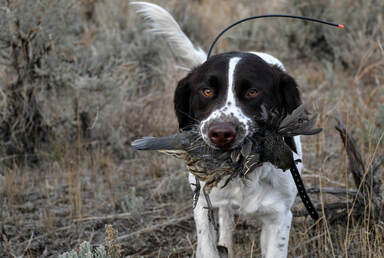 Yes, you read Part I right, Ila didn’t get to go Chukar hunting. Not quite a year and a half old, she still has to pass her OFA exams, prelims or not, and Fowler had been nursing a sore wrist. They were going to get to hunt Valley Quail. Sure, we have them in our surrounding areas at home, but not in places where you can hunt them mostly. In fact, one of the best indicators of Prime Valley Quail habitat is – can they be hunted here or not? If it’s legal, odds are you will not see them, and if you do, they will be like an apparition – did you really see what you thought you saw? If it’s not legal, the little winged turds will strut around with reckless abandon. Some say their call sounds like Chi-ca-go, all I hear is Suck-it-Monkey. 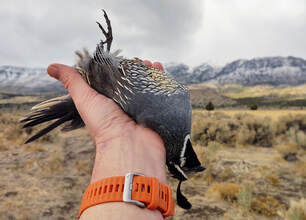 Jenna is becoming an adept habitat researcher. Juggling OnX, Google Earth, researching various blogs (seriously, I have no idea how she finds this stuff), and heaven only knows what. She decreed, “we need to hunt the area around the old center pivots up the road”, and so we did. We took the road to the west of the irrigation assemblies; it was a checkerboard of private and public lands. Which to me wasn’t exciting. But if you reference the above paragraph it had the effect of increasing the likelihood of finding these tricky little guys. As if on cue, we were approaching a break from private to public, and a covey was crossing the road – they were legal. Flirting with disaster, living on the wild side, all of fifteen feet of legal. If we got them to flush north, we could hunt them.  Quickly I got Ila out and let her work the covey – yes, straight out of the truck! Bam, she had them. I didn’t fool around and moved smartly past her point hoping to flush them deeper onto the public land, and maybe get lucky. Flush they did and just like the Rebel Fighters attacking the Death Star, they juked and jived through the sage brush as if they were rocking their speeders back home in Beggar’s Canyon, just like Luke Skywalker evading a squad of TIE fighters. No shots for me, worse yet, they flushed almost perfectly parallel to the property line – still barely legal (don’t Google that). 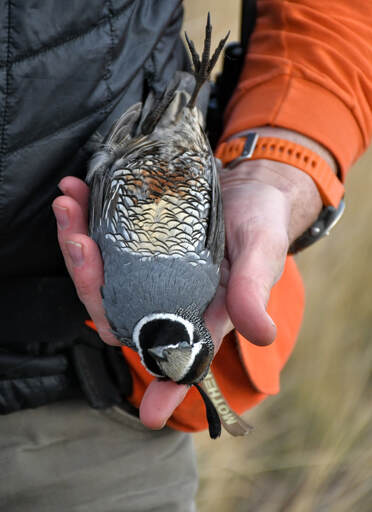 As Ila and I approached them again, many were easy to see, running on the desert floor here and there. She would point, look to me. Relocate. Point again. It was a chaotic scene for sure. She made a good point in front and pointing at me. The quail flushed at me, and regrettably I shot. The bird was rendered to a lump of quail-burger hurtling through time and space. I ducked so as not to be hit by it. The quail’s ruined carcass hit the desert floor with an unceremonious ‘thock’. Ila still steady despite all of this. I gave her the ‘hunt dead’ with quail still running hither and thither. She really didn’t know what to do, but she slowly worked towards me. Then abruptly the covey flushed again back to the truck. Clearly, they had the property line wrong by just the right amount! Ila located the crumpled bird and really had no interest in it. She literally looked up at me as if to say, “what is this”? I gave her a ‘here’ cue and stepped away. She grabbed the shattered bird ever so reluctantly and brought it towards me. Gawd, what a hit. That poor quail was a terrible mess. But hey, we were on the board! 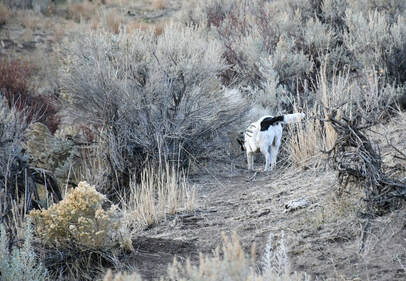 We hustled back to the truck, where our friends were waiting. Ila picked them back up and quickly made a point. The quail were over this and began flushing north more deeply into the public land in desperation to get away from us. One bird abandoned the ‘Beggar’s Canyon’ mindset and flew high. It was an unfortunate decision for him. What a lovely little cockbird. Ila retrieved him with aplomb to hand. We decided it was time to let these guys be and departed for the area South and East of the old irrigation rig. 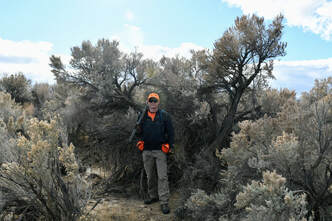 The southern edge was home to a large coulee running west/east filled with high brush, just the sort of thing valley quail love. It was a short out and back, and so we ran Fowler here due to his wrist injury. Within moments he was in the birds. They weren’t making mistakes and it wasn’t long before he was showing sign of being uncomfortable, so we wrapped it up. Another much larger but similar coulee system ran north/south joining the previously mentioned drainage not far from where we were parked. Tule and Powder hunted hard, but the only thing they managed to find were rabbits, and we discovered an ancient stand of giant sage. We took a moment to marvel these enormous bushes. Several of which exceeded ten feet in height. 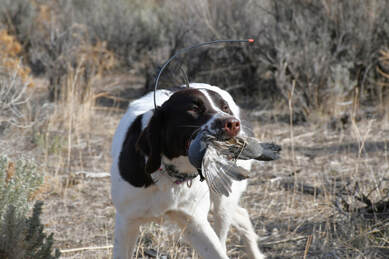 Back to our regularly scheduled programing. All Ila, All the time. It was late in the day, and we wanted to give Ila another shot at the valley quail. We decided to put her on Fowler’s run and see what may come of it. She picked the quail up, pretty much in the same place Fowler did. She made her point between the steep edge and the tall, thick, and impassable brush. I gave her an ‘alright’ in hopes she might get them up for a shot. But what happened was she worked the birds through until she emerged on the other side where she went back on point. I was flabbergasted as to what to do next.  Thirty some odd yards away, but she may as well have been a mile away on the other side of molten lava – I wasn’t going to be able to get to her. The quail cracked first and flushed. A pair came back over towards us, I have no real idea where the others went. Ila stood steady to the flush. I waited a moment, then asked her to come in, which she did with great enthusiasm. I told Jenna I had an idea where the two birds went, and we set out in their direction. Ila canvased the desert floor then suddenly, she skidded to a stop ending with a dramatic point. Clearly the bird was pressured, and it flushed giving me a high-speed passing shot. The first shot caused him to rock in the air, the second caused him to fold up. I looked back, with Ila still standing, gave her the ‘hunt dead’ cue, and off she went. We searched, and searched and was near to giving up, when suddenly the little dog found the bird tightly nestled in a thorny bramble at the base of some desert brush! 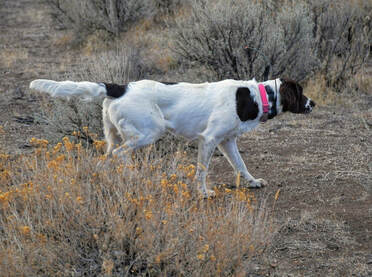 In the area, we were able to cross over the channel cut in the desert floor without difficulty and began heading back to the truck. It wasn’t long before Ila became birdy. Point, go, point, go. She was managing running birds. Then somehow, they were visible. Possibly a dozen or more, running to and fro. Crossing one another’s paths with Ila standing in the middle of them. Picking her feet up like a cat on a hot tin roof. I gave her a recall since she about to lose her edge and start chasing them around. Then the quail went up and over the small ridge never to be found again. This is why it’s called bird hunting and not bird getting. The dogs are always learning and improving, just as I to continue to learn and improve as an amateur naturalist and dog handler. I suppose I too will only get a little better so as long as we continue to learn together. |
Categories
All
Our YouTube Content
Two GunI'm just a guy suffering with an infatuation with gundogs since childhood. Forty some years later this is what you get. Archives
March 2024
|
|
|
